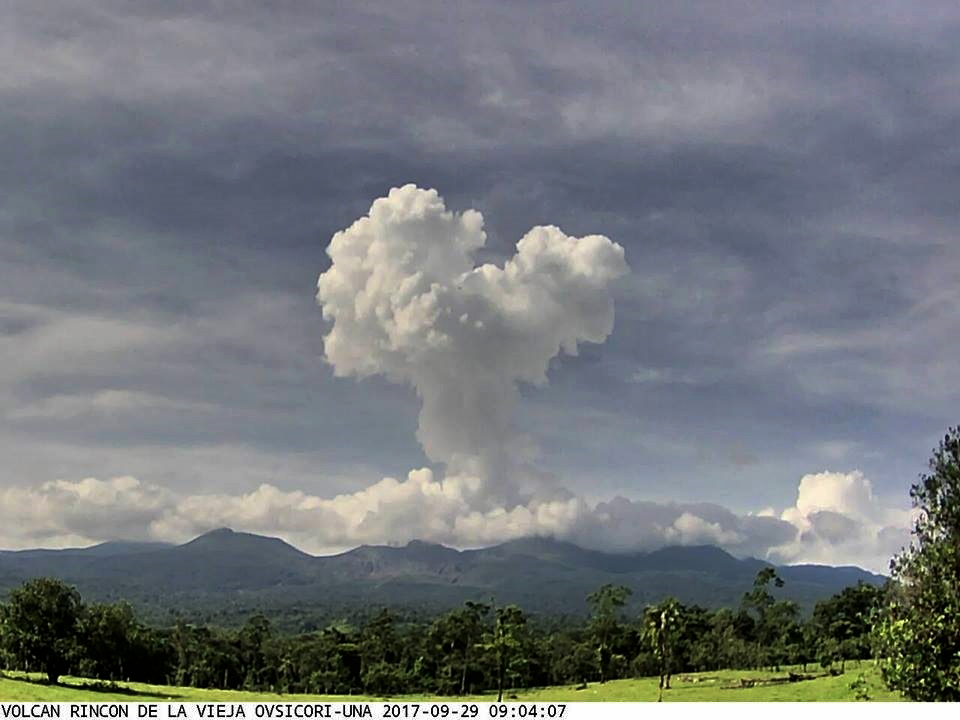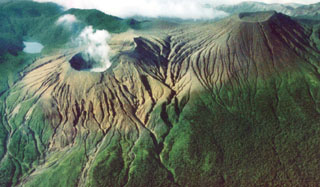Report on Rincon de la Vieja (Costa Rica) — March 2018
Bulletin of the Global Volcanism Network, vol. 43, no. 3 (March 2018)
Managing Editor: Edward Venzke.
Rincon de la Vieja (Costa Rica) Phreatic explosions during 29 September-22 October 2017
Please cite this report as:
Global Volcanism Program, 2018. Report on Rincon de la Vieja (Costa Rica) (Venzke, E., ed.). Bulletin of the Global Volcanism Network, 43:3. Smithsonian Institution. https://doi.org/10.5479/si.GVP.BGVN201803-345020
Rincon de la Vieja
Costa Rica
10.8314°N, 85.3364°W; summit elev. 1729 m
All times are local (unless otherwise noted)
During the first half of 2017, phreatic explosions at Rincón de la Vieja occurred on 23 May, 11-12 June (however, clouds obscured visible observations), 18 and 23 June, and 5 July (BGVN 42:08). This report describes activity from 6 July through December 2017. Information comes from the Observatorio Vulcanológico Sismológica de Costa Rica-Universidad Nacional (OVSICORI-UNA).
After a small phreatic explosion on 5 July 2017, there were no further reports of any explosions until 29 September when OVSICORI-UNA reported that at 0848 a small phreatic explosion produced a plume that rose 1 km above the crater rim (figure 27); material also flowed down the S flank.
 |
Figure 27. Webcam image of a phreatic explosion at Rincón de la Vieja on 29 September 2017. Courtesy of OVSICORI-UNA (color adjusted). |
According to OVSICORI-UNA, events on 3 October at 0848 and 1445 generated plumes that rose 700 m and 1,500 m, respectively. OVSICORI-UNA also reported that on 9 October at 1048, a small explosion produced a plume that rose 700 m above the crater rim. According to news reports (The Costa Rica Star and CRHoy.com) quoting OVSICORI-UNA, an explosion on 22 October at 0640 generated a steam-and-gas plume that rose about 1 km above the crater. There were no further reports of an explosion through the end of December.
Geological Summary. Rincón de la Vieja is a volcanic complex in the Guanacaste Range of NW Costa Rica. Sometimes referred to as the Rincon de la Vieja-Santa María Volcanic Complex, it consists of a slightly arcuate 20-km-long ridge of 12 craters and pyroclastic cones constructed within the 15-km-wide early Pleistocene Guachipelín caldera, whose rim is exposed on the south side. Sometimes known as the "Colossus of Guanacaste," it has an estimated volume of 130 km3 and contains at least nine major eruptive centers. The Santa María cone, the highest peak of the complex, is located on the E side of the ridge and has a lake within the 400-m-diameter crater. A Plinian eruption producing the 0.25 km3 Río Blanca tephra about 3,500 years ago was the last major magmatic eruption. All subsequent eruptions, including numerous reported eruptions possibly dating back to the 16th century, have been from the active crater, near the center of the complex, with an acidic 300-m-diameter lake.
Information Contacts: Observatorio Vulcanológico Sismológica de Costa Rica-Universidad Nacional (OVSICORI-UNA), Apartado 86-3000, Heredia, Costa Rica (URL: http://www.ovsicori.una.ac.cr/, https://www.facebook.com/OVSICORI/); CRHoy.com (URL: http://www.crhoy.com/); The Costa Rica Star (URL: https://news.co.cr/).

